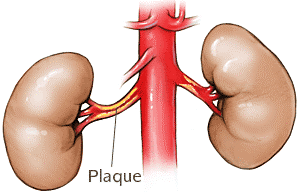RENAL ARTERY STENOSIS
 Renal artery stenosis is a condition where the arteries leading to the kidneys become narrowed and blocked from the build up of plaque along the artery walls. This condition often worsens over time and can lead to kidney failure if untreated.
Renal artery stenosis is a condition where the arteries leading to the kidneys become narrowed and blocked from the build up of plaque along the artery walls. This condition often worsens over time and can lead to kidney failure if untreated.
Risks and causes
Renal artery stenosis is typically caused by atherosclerosis which is the build up of plaque. Risk for this condition is the same as the risks for atherosclerosis anywhere in the body:
- Ageing
- Diabetes
- Genetics
- High blood pressure
- High cholesterol
- Obesity
- Smoking
Symptoms
Most people with renal artery stenosis have no symptoms until the disease advances to a critical state. This condition should be suspected in patients who have severe hypertension which does not respond to medications. This is especially so if there is also worsening kidney failure.
Diagnosis
Renal artery stenosis is usually evaluated with an ultrasound as the initial test. A renal artery duplex ultrasound can often see flow velocities which are elevated. This indicates a narrowing in the artery. Patients with a suspicious ultrasound will have further evaluation with a CT scan, an MRA, or an angiogram.
Treatment
Renal artery stenosis is most commonly treated with angioplasty and stenting. This procedure is performed via a small puncture in the artery in the groin (femoral artery). Advanced x rays are used to position the stent in the exact location of the narrowed renal artery. The stent serves to hold the artery open and allowing the free flow of blood into the kidney.
Conservative treatments focus on lifestyle change to address atherosclerosis. These include exercise, diet, reducing stress and smoking.
Sometimes this conditions is treated by addressing the risk of high blood pressure. High blood pressure can be treated with medications. This can be a process and must be coordinated with a qualified doctor.
